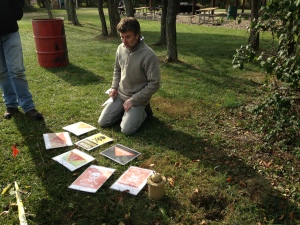
Paul Burton of Global Journalist Security displays signs that indicate nearby mines. (Aimee Keane/MEDILL)
WASHINGTON – Even for the most experienced conflict journalist, reporting in an active war zone like Syria in its current climate has never been more dangerous.
With the ISIS insurgency comes an unprecedented risk of kidnapping, torture and death in these conflict zones. According to the New York-based Committee to Protect Journalists, more journalists are missing in Syria than in any other country in the world. Whether these journalists are being held hostage or have been executed remains unknown.
Frank Smyth, a former investigative reporter and author of the CPJ’s Journalist Security Guide, said the risk assessment journalists complete before even booking a plane ticket is the crucial step in reporting on this kind of conflict. This includes finding concrete answers to questions like who are the potential hostile subjects on the ground? How could the reporters’ nationalities and profiles increase or decrease the risk of being a target? How will the reporters communicate locally and abroad? It’s only when the reporters and the news agency are comfortable with the risk assessment that reporters should make plans to travel.
Smyth is also the founder and executive director of Global Journalist Security, a hostile environment training firm that operates classroom and simulated scenario workshops to prepare journalists for conflict reporting.
“In past decades, the role and practice of journalism was respected,” Smyth said via phone, “but now insurgent groups and governments don’t need journalists to get the message out.”
That’s because these groups are pushing out news and organizational propaganda on their own social media sites. An article published in June in The Atlantic reported that hashtags created by ISIS were seen on Twitter more than 10,000 times per day while al-Nusra generated hashtags that averaged 2,500 to 5,000 mentions per day.
In the past, journalists might have covered up certain religious affiliations. Even Steven Sotloff, the American journalist beheaded by ISIS in September, was able to conceal from his captors that he was Jewish. Smyth said that ISIS has now likely read about what Sotloff did to conceal his religion and will not allow it to happen again.
“You should presume they will find out everything about you,” Smyth added.
Smyth emphasized that a reporter and his news agency need to figure out if the risks on the ground are worth it. This comes back to the risk assessment plan.
“Even if you did it all right, things can so quickly… we’ve never seen a group quite as absolute extreme as [ISIS].”





